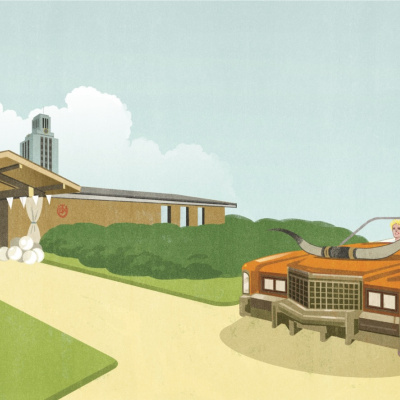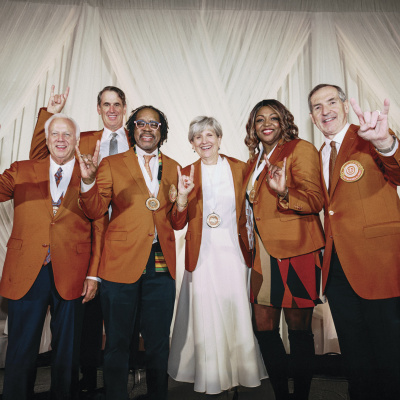Good Reads Q&A: This Debut Novel Puts an Austin Boxing Gym at the Center of an Intergenerational Mystery

As Austin, Texas, steps into its place in the national zeitgeist, more and more contemporary writers have tried to capture its unique spirit, to varying degrees of success. So when a novel set in Austin with such an unusual plot and cast of characters starts to earn literary buzz months out from publication—and it also happens to be written by a Texas Ex—this reporter will surely take notice.
Lucas Schaefer’s debut novel, The Slip, out from Simon & Schuster on June 3, 2025, centers on Terry Tucker’s Boxing Gym, a meeting place for every facet of the city’s identity. Across the decades, gymgoers past and present (along with one missing person) tell an indelible story of race and sex in America. The Alcalde spoke with Schaefer, MFA ’15, ahead of the book’s release.
Where did your interest in writing fiction begin?
I have always wanted to be a novelist—but didn’t do it for years and got a job at the Girls School of Austin, where I was a seventh grade teacher for 10 years. And then I met my husband, Greg [Marshall], who is a fiction and nonfiction writer, and he was at the Michener Center [for Writers’ Master of Fine Arts program] when we met. And I was like, Why does this guy get to do what I want to do?
I went to UT’s New Writers Project after Greg graduated, and I really got serious about fiction.
I mean, I was in a writing group in Austin for many years and certainly had been writing, but not with the seriousness to complete a novel—or the novel I wanted to write. So I sort of blame Greg for this.
How did this project begin?
For all of grad school, 2013 to 2015, I was writing short stories set at this gym and getting to know the characters and all of that. And then 2016 rolls around, I’m out of school, and I’m trying to put this all together into a short story collection, and it was like, Wait a second, these are very intricately linked. I could do a linked collection—or I could just write a novel.
As a writer, I’m very interested in those places and situations in which people who are generally segregated in society are thrown together. People of different races, people of geographic difference, sexuality, gender, class. And when I first moved to Austin in 2006, I started going to a boxing gym here—not sparring, but just for exercise and as a place to meet people. And I thought, That’s a setting I can work with.
The book, to be clear, has departed very seriously [from that gym]. There’s not a character in the book where you’d be able to tell, “Oh, this is this person.” Both as a reader and a writer, I’m not really an autofiction person. I want fiction with a capital F.

Were you conscious at all of genre as you were writing?
I didn’t conceive of the book as a mystery even though there’s a missing boy at the center of the story. A big breakthrough for me [as a writer] was starting to read mysteries. I read Razorblade Tears [by S. A. Cosby], and I read Attica Locke, and I read Richard Price—these real heavyweight crime writers ... But I don’t think you’ll read it and think it’s a typical mystery.
I am naturally a character-driven writer. I had such a great education at UT, and I left knowing how to write characters and setting, and also what a book needs and having the discipline to actually do it. What I learned from reading mysteries, though, was plot: How do you get things moving and keep it moving?
How is Austin its own character in the book?
I really wanted a full picture of the city. In the popular imagination, we may think of old hippies keeping Austin weird. And that’s absolutely in the book and absolutely a part of the city. But there are also people who were here before that, and there are people in different parts of the city. Austin is a fairly segregated place, as is the United States.
I did all of this research at Austin History Center while I was writing this book, and I read at one point—I’ve never learned if it was actually true—that the population of Austin has doubled every 25 years since the Civil War. I liked the idea of every generation complaining, because unless you are indigenous to Austin, you have probably been part of the decline that you are complaining about. So I wanted to play with that. And, you know, it’s also just a place where there is a lot going on.
How do you think about telling a story set in the past that deals with many similar issues as current events?
Any time you go into a project and you’re overly focused on what’s happening right now, it becomes too hard to have the imagination to really make it work. There was a draft when I sold the book that had a COVID-19 plotline. The story went 10 years later than the book does now. In addition to [that plotline] not working, it was too on the nose.
Recently I was laughing because the book was labeled somewhere as “historical fiction,” and I’m like, Wait, what? But in a way it is, right? It’s set almost 30 years ago. I was able to write about our moment from a remove that let me think about it in a more free and interesting way.
This interview has been edited and condensed.
CREDIT: Greg Marshall, MFA ’13






